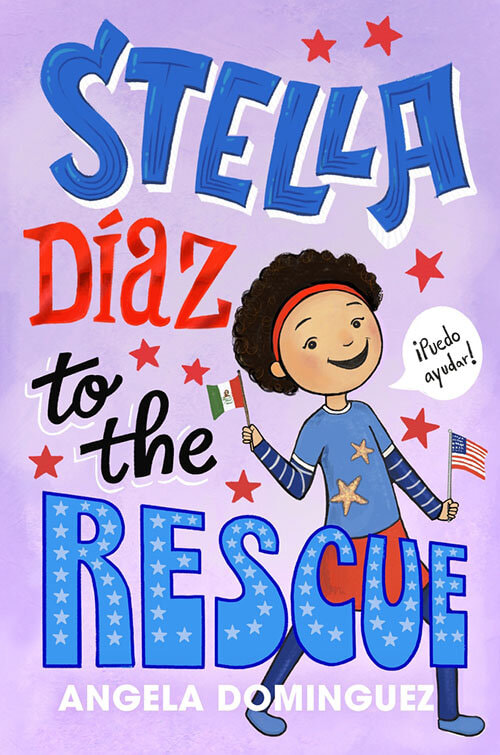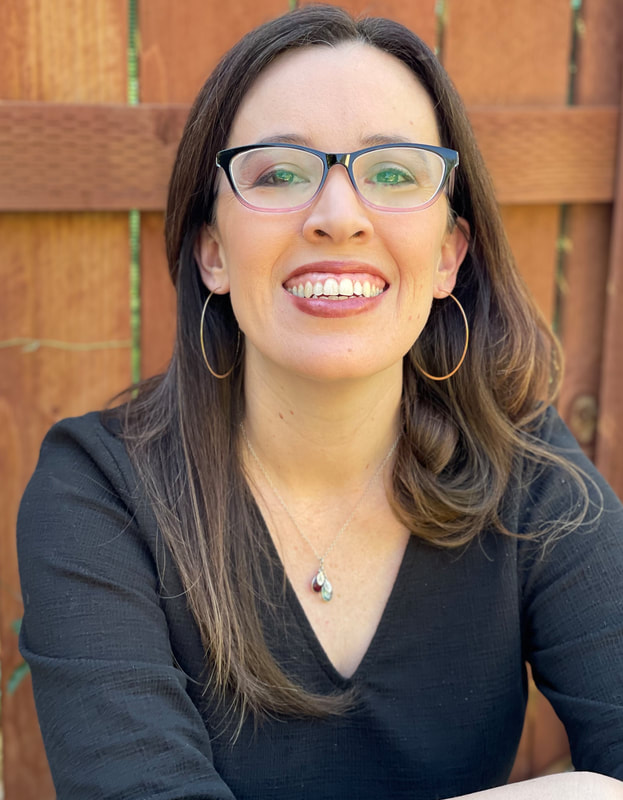|
Even when she’s turning roja, Stella Díaz is so full of heart, a character you can’t help but cheer for as she finds her voice and realizes she is más valiente than she realized. Today, Las Musas Madrina Jennifer Torres is thrilled to interview author-illustrator and Las Musas Madrina Angela Dominguez about the latest book in the Stella Díaz series, Stella Díaz to the Rescue. Here’s a description from publisher Roaring Brook Press: In Stella Díaz to the Rescue, the latest in this beloved series from award-winning author Angela Dominguez, Stella learns that sometimes the best way to help others is just to be there for them when times get tough. It’s a new calendar year, and Stella is determined to make it her best one yet. Not only are Stella and her family finally becoming U.S. citizens, but the Sea Musketeers are also presenting their plastics pledge to the school council. With her trusty schedule in hand, Stella is ready for anything! But after life takes unexpected turns, Stella will have to fight to keep her perfect year on track. Not to worry, because Stella Díaz is to the rescue! Right? Jennifer Torres: When this latest chapter in Stella’s journey opens, her mom is preparing to take the naturalization test, one of the last steps toward the family becoming United States citizens. And, at the heart of the story seems to be an exploration of what it means to be a good citizen. What do you hope readers take away as Stella grapples with this big question? Angela Dominguez: That is such a great question. On one hand, I would hope it would encourage kids to think about their communities and how they can help. Whether it’s caring for the environment or simply sharing with others. It’s easy to get caught in our own problems and forget that there are other people in the world, especially in these past two years where we have spent more time alone. At the same time, it’s also a conflict for Stella because she takes the idea of being a good citizen to the extreme. She tries to solve other people’s problems who really aren’t looking for help. I hope the book provides an opportunity for kids and adults to have conversations about ableism. Stella makes mistakes so hopefully we don’t make as many. Jennifer: In all of the Stella Díaz books, and this one especially, I love that the illustrations give us an extra glimpse into Stella’s world and her perspective. How do you decide what to illustrate in each chapter? Angela: I always like an excuse to draw sea creatures. Not only are they fun to look at, some of the ones I mention in the books are not as common so it’s helpful to have illustrations of them. The rest of the drawings are typically big moments where Stella meets someone new or has a strong emotion. Although it is exciting to draw historic figures and imaginary moments, too, like a zombie eating take-out or Stella running to the rescue. Jennifer: Maybe because I was a shy kid, I’m drawn to stories about quiet courage and bravery that doesn’t look the way we typically expect it to. That’s a big part of why I love Stella so much! Can you share a bit about how you’ve approached showing Stella’s growing confidence and sense of her own voice from book to book? Angela: I was very much a shy kid, and I’m still an introvert. I spent half of my childhood roja like Stella. In some ways, Stella’s growing confidence has mirrored my own as an author. Seeing readers respond and relate to Stella, encourages me to keep writing. However, Stella has become her own person too beyond my own experiences. I’ve been inspired by young, motivated women like Greta Thunberg and AOC who are determined to solve big problems. I believe Stella might grow up to be like them one day. Jennifer: The relationship between Stella and Nick is one of my favorite parts of this series. In this book we see them grow together, but also in their own individual directions. Where do you draw inspiration for the sibling relationship and especially its changes over time? Angela: Like Stella, my parents divorced when I was young, so I grew up mostly with my mom and brother. Mi hermano became a surrogate father to me in many ways and I still look to him for fatherly advice. That said, Nick is sort of an idealized version of him. Nick steps in like a dad would or my brother would. However, he’s still a teenager and forming his own identity. In the books, Nick offers advice, support, and the occasional eye roll. He just fights less with Stella than my own brother did. (Don’t tell him that.) Jennifer: Stella and her and her art club classmates have a special new project: portraits of school staff and faculty members, inspired by pieces at The Art Institute. Do you create many portraits or self-portraits? Do you have any advice for young artists on how to begin a portrait? Angela: I love portraits. I used to draw many of them growing up and even more at art school. In fact, when I was trying to improve my skills in college, I decided to complete a 100-portrait project in my sketchbook. For aspiring artists who want to try their hands at portraits, I recommend the blind-contour exercise that Stella does in her art club. It is a great way to have fun and practice your observation skills. To start, you either use a mirror or have someone sit for you, while you draw. Next, draw slowly what you observe without looking at the paper. Take the time to notice all the details. It’s freeing and you’ll be surprised how great it can look. On top of that, try different art mediums. Sometimes it takes a while to find the one you love. Jennifer: Stella’s shaky Spanish has her worried that she’s not Mexican “enough” (something I’ve definitely related to). This feeling seems to deepen when she thinks about what it will mean to become a U.S. citizen, all leading to one of my favorite moments in the book, when Stella says, “I love that I can be so many things at once.” To what extent are Stella’s thoughts about citizenship and identity inspired by your own immigration experience, which you share in an author’s note? Angela: As you may have noticed, much of the book is inspired by my experiences, but this one really hits close to home. As a child, I felt caught between cultures and not feeling Mexican “enough.” I still struggle with this today to a degree. One offhanded remark about how I pronounce something in either English and Spanish today can trigger some painful feelings or insecurities. But what I have been amazed to realize as I have gotten older is that many people from all types of backgrounds feel this way too! What I perceived as a singular feeling is not that at all which is partially why I write about it today. I hope it will help kids feel less alone to know they have a character they can relate to. More importantly, I hope it might inspire kids to have pride in all parts of their identity as well. Jennifer: Here’s a question from my daughter Soledad, who is a 9-year-old aspiring artist and major Stella Díaz fan (They were the first books she called her favorites!): Does Stella ever make decisions that are different from what you would have done? Angela: Great question, Soledad! I think the biggest difference between Stella and myself is she thinks coffee is gross while I’ve been drinking it for quite some time. Truthfully, most of her decisions are similar to what I would have done in those situations. In fact, my boyfriend jokingly says WWSD (or What Would Stella Do) when I’m nervously trying something new. I think Stella is perhaps braver than me. She’s been able to speak up to bullies, for example. She’s probably a little more superstitious than me, too. Jennifer: Stella Díaz to the Rescue is just one of many beautiful books you have releasing this year. Can you tell us a little about what else has been in the works for 2022? Would you say there are any common threads that run through these projects? Angela: I’m happy to have more Stella out in the world, including the paperback edition of STELLA DÍAZ DREAMS BIG (the third book in the series.) I also had the privilege of illustrating JUST HELP! by Sonia Sotomayor which came out in January. That shares some overlapping themes of civic duty and stepping in to help our communities. I also have two additional picture books that I both wrote and illustrated. One is called I’M HUNGRY/¡TENGO HAMBRE! It’s about a dinosaur who is hungry, but he’s a picky eater. That is a very silly book that was such a complete joy to illustrate. It’s in the same vein as some of my other early bilingual picture books like HOW ARE YOU? or HOW DO YOU SAY? Lastly, I have a picture book called ME GUSTA. With this book, I wanted to celebrate Latino families and the joys and issues that go through today. With all my books, I hope to share a bit of myself and celebrate my heritage in different ways. While I have to say while the pandemic has been stressful, it has allowed me more time to be at home and luckily, work on more books. I’m grateful and excited to be able to share them with readers this year. Find Angela and her amazing books online!  Angela Dominguez was born in Mexico City and grew up in the great state of Texas. She now resides on the east coast with her boyfriend, Kyle, and their petite dog, Petunia. She is also the author and illustrator of several books for children and a two-time Pura Belpré Illustration Honoree. Her debut middle grade novel, Stella Díaz Has Something To Say, was a New York Public Library and a Chicago Public Library pick for Best Books for Kids, Sid Fleischman Award winner, and an ALA Notable. She recently illustrated the New York Times Bestseller, Just Help! How to Build a Better World, written by Sonia Sotomayor. When Angela is not in her studio or visiting schools, she teaches at the Academy of Art University, which honored her with their Distinguished Alumni Award in 2013. Angela is a proud member of SCBWI, PEN America, and represented by Wernick and Pratt Literary Agency. As a child, she loved reading books and making a mess creating pictures. She’s delighted to still be doing both.
0 Comments
Leave a Reply. |
Las Musas SpeakWelcome to our blog! Archives
July 2024
Categories
All
|



 RSS Feed
RSS Feed